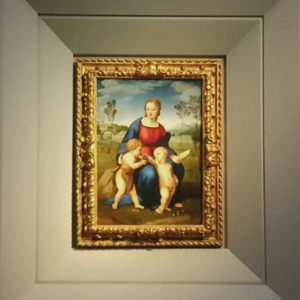 Earlier this month, the Uffizi Gallery in Florence debuted its “Raphael and Michelangelo Room” as part of a larger rearrangement of the museum. Housed in Room 41 of the building, the Raphael and Michelangelo Room – as one might expect – contains paintings from the two Renaissance masters.
Earlier this month, the Uffizi Gallery in Florence debuted its “Raphael and Michelangelo Room” as part of a larger rearrangement of the museum. Housed in Room 41 of the building, the Raphael and Michelangelo Room – as one might expect – contains paintings from the two Renaissance masters.
Two paintings by Raphael dating to 1404-05 – portraits of a Florentine merchant, Agnolo Doni, and his wife, Maddalena Strozzi – were moved from the Palazzo Pitti to the Uffizi. In the newly rearranged room, they sit in a glass case that displays both the front and the back of the paintings. On the back is a diptych by another artist in Raphael’s workshop, the Master of Serumido, that wishes Doni and Strozzi a fertile marriage through scenes of the legendary Greek Deucalion and Pyrrha, who repopulated the Earth after a flood.
Next to the portraits are other Raphael portraits, as well as the Doni Tondo, a round Michelangelo painting showing the Holy Family. It was a gift from the artist to Doni and Strozzi upon the birth of their daughter, Maria, the next year. Also in the room is Raphael’s “Madonna of the Goldfinch,” painted for the prominent Nasi family, which was moved from a crowded corridor in the Uffizi.
The room represents a point in time when the Medici family, who ruled Florence from 1434 to 1737, was in exile. During this time, from 1498 to 1512, Florence was a republic, and artists who had pieces commissioned by the Medici scrambled for business from other patrons. As patrons competed to secure paintings by the Renaissance masters, the Doni family was the only one – aside from Pope Julius II and Pope Leo X – who managed to commission pieces from both Michelangelo and Raphael.
The Raphael and Michelangelo Room also contains works by lesser-known artists to create intellectual and visual interest. Fra Bartolommeto (1473-1517), a Dominican friar and Raphael acolyte, has three paintings on display, while a Hellenistic sculpture highlights Michelangelo’s connection to antique sculpture.
The protective glass cases surrounding the paintings are built to withstand earthquakes and other forces while keeping data on the paintings’ humidity and temperature. The cases also allow guests to come right up to the glass.
“We want this to be a 22nd-century museum,” Eike Schmidt, the Uffizi’s director, told the New York Times. He said that with this technology, the Uffizi “has gone beyond what the Getty and the Met have done.”
Next month, three Leonardo da Vinci paintings will be moved to a nearby room. That plus the Raphael and Michelangelo Room creates “a magic moment in the first decade of the 16th century when Florence was the cultural and artistic center of the world,” Schmidt said.
By Kathy McCabe
